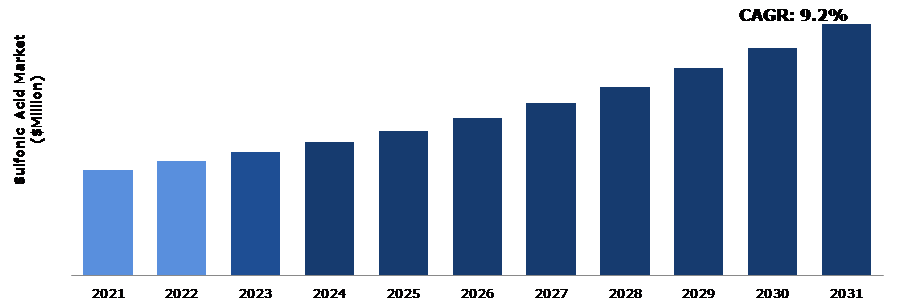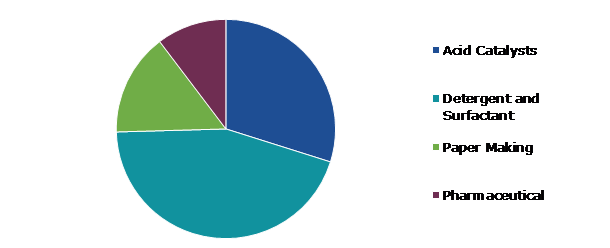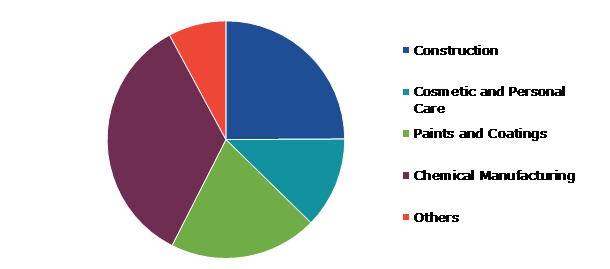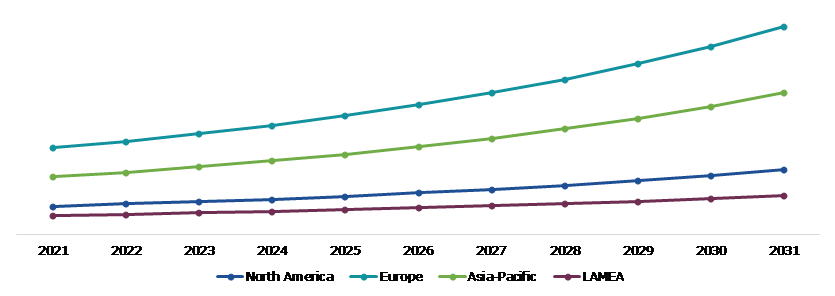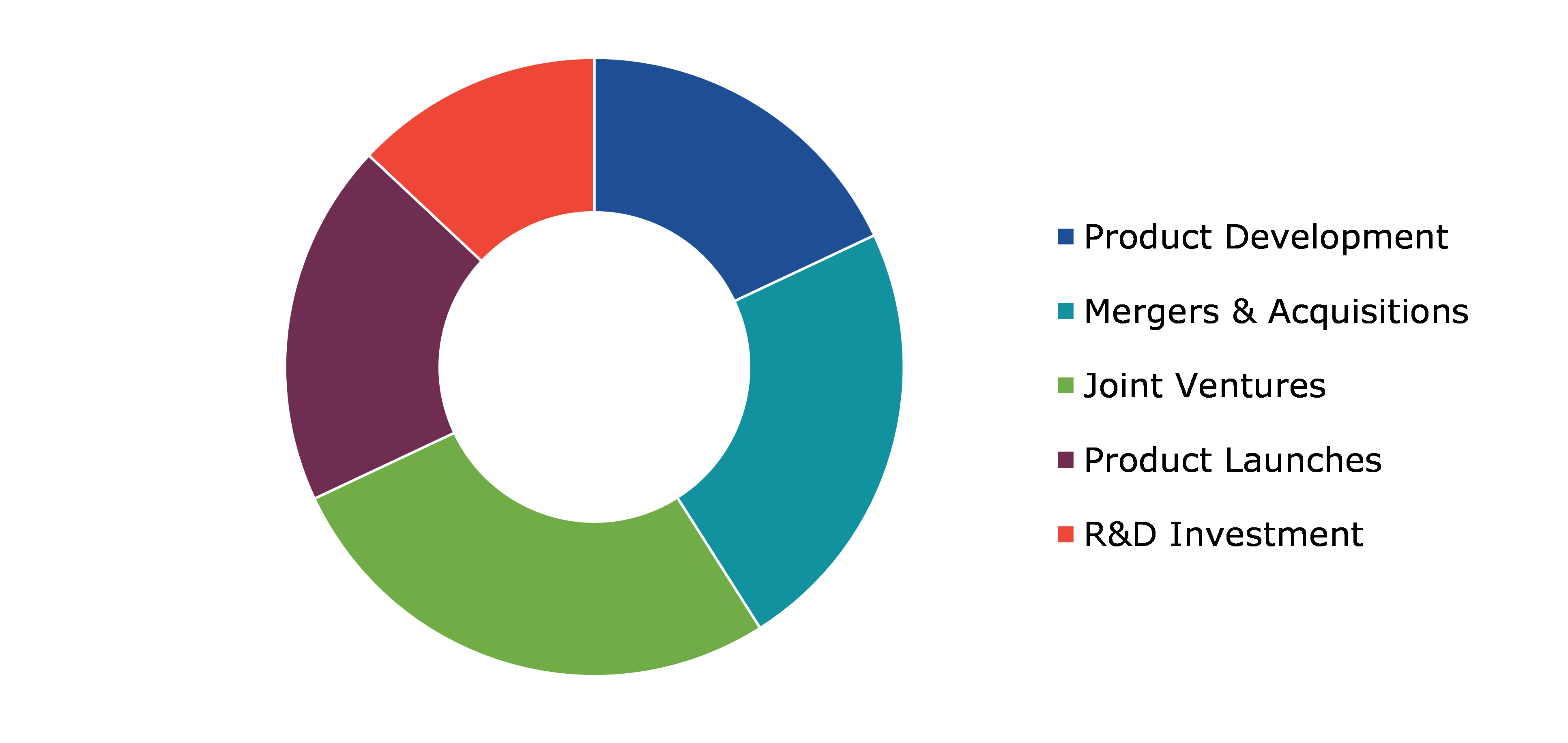Global Sulfonic Acid Market Report
RA08628
Global Sulfonic Acid Market by Application (Acid Catalysts, Detergent & Surfactant (Heavy-duty Laundry Liquid, Laundry Powder, Light-duty Dish-washing Liquid, Industrial Cleaners, and Household Cleaners), Paper Making, and Pharmaceutical), End-use Industry (Construction, Cosmetic & Personal Care, Paints & Coatings, Chemical Manufacturing, and Others), and Region (North America, Europe, Asia-Pacific, and LAMEA): Global Opportunity Analysis and Industry Forecast, 2022-2031
Global Sulfonic Acid Market Analysis
The Global Sulfonic Acid Market Size was $700.1 million in 2021 and is predicted to grow with a CAGR of 9.2%, generating a revenue of $ 1664.7 million by 2031.
Global Sulfonic Acid Market Synopsis
Demand for detergents and personal care items containing sulfonic acid has significantly increased as a result of changing lifestyles and altering consumer preferences toward environmentally friendly products. The rising demand for detergents and cleansers to meet hygiene standards has resulted in a rise in demand for sulfonic acid. Also, industrial hygiene standards in the pharmaceutical, food and beverage, chemicals, healthcare, and many other industries have led to an increase in demand for detergents for industrial cleaning applications, which has resulted in an increase in demand for the sulfonic acid market share growth.
Sulfonic acid is a great choice for many applications, but there are some disadvantages to using sulfonic acid. First, sulfonic acid is less soluble in water than other types of acid. This means that it will take longer to disperse the sulfuric acid throughout a solution. In addition, sulfonic acid can also result in an adverse reaction with other ingredients in a solution.
Sulfonic acids are relatively a new class of materials that have a number of potential future applications. Some of these applications include the manufacture of solar cells and other energy-related products, the development of new pharmaceuticals and biologics, and the production of new coatings and adhesives. The wide range of potential uses makes sulfonic acids an exciting prospect for investors and manufacturers.
According to regional analysis, the Asia-Pacific sulfonic acid market size accounted for $700.1 million in 2021 and is predicted to grow with a CAGR of 9.2% in the projected timeframe.
Sulfonic Acid Overview
Sulfonic acid, usually spelled sulphonic, is a class of sulfur-containing organic acids with the general formula RSO3H, where R is an organic combining group. Sulfonic acids rank among the most significant of the organosulfur compounds; the free acids are frequently used as catalysts in organic synthesis, while the salts and other derivatives serve as the building blocks in the production of detergents, water-soluble dyes and catalysts, sulfonamide pharmaceuticals, and ion-exchange resins.
COVID-19 Impact on Global Sulfonic Acid Market
The coronavirus pandemic hampered the expansion of the sulfonic acid market. Manufacturing operations and logistics activities were restricted by strict lockdowns, quarantine, and social isolation, which interrupted supply networks. This has ultimately lowered the demand for sulfonic acid due to disruptions in the supply chain, closure of manufacturing plants, as well as economic slowdown across several countries. In addition, import-export restrictions were laid down on major sulfonic acid-producing countries such as China and many others. For instance, in the construction industry, several construction projects were postponed or canceled due to a shortage of raw materials, and labor, fear of contracting the COVID-19 virus among workers, as well as travel restrictions. Sulfonic acid is used in chemical synthesis as a major synthesis material and for making various chemicals. However, disruptions in the import exports as well as the closure of chemical and manufacturing units have hampered the sulfonic acid market share during the pandemic.
Increase in the Use of Sulfonic Acid as an Efficient Catalyst in Various Applications to Drive the Market Growth
Acid catalysis is frequently employed in the chemical industry due to the wide range of chemical syntheses that involve acids. Apparently, the bulk of plants still rely on homogeneous catalysis, and while liquid mineral acids (such as H2SO4) have good catalytic activity. However, these compounds are extremely corrosive to equipment and dangerous to the environment; they must be employed in large quantities, and they are difficult to separate and recover. Many efforts are being made to replace the more prevalent homogeneous catalysts with heterogeneous ones in order to make industrial processes greener and more sustainable. Solid acid catalyst design and manufacture have seen a substantial rise in interest in recent years. Sulfonic solid acid materials are a viable substitute for homogenous mineral acid in a number of acid-catalyzed processes in this context. They are long-lasting, effective, and adaptable catalysts for the production of several important compounds. All these factors are anticipated to boost the sulfonic acid market size.
To know more about global sulfonic acid market drivers, get in touch with our analysts here.
Sulfonic Acid’s Negative Effects on the Environment and Human Health to Restrain the Market Growth
Sulfonic acid is a common synthetic surfactant. The sulfonic acid-based detergent produces stains on the cloths, also the detergent with high content of sulfonic acid may leave a sticky layer and even a blue stain on clothing. Although sulfonic acid is biodegradable, its widespread presence in the environment affects water bodies. Also, it has the potential to induce nausea, skin irritation, and diarrhea. As a result, the environmental and health consequences of sulphonic acid will impede market expansion.
Increase in the Demand for Sulfonic Acid in Various End-use Industries to Drive Excellent Opportunities
In the textile and clothing industries, sulfonic acid is frequently used for scouring, sizing materials, soaping all textiles, and removing oil from clothes. The use of sulfonic acid is increasing as a result of increased investments and the construction of new facilities in the textile and apparel sector. In addition, hospitals frequently utilize sulfonic acid-based detergents for cleaning and washing patient and healthcare staff clothing to preserve hygiene. In addition, a number of industries have adopted industry standards for hygiene including the food and beverage, pharmaceutical, healthcare, chemicals, and many other sectors have increased demand for detergents used in industrial cleaning applications, which in turn has increased demand for the sulfonic acid market. Also, other factors expected to fuel sulfonic acid market growth include growing industrialization, expanding acceptance of biodegradable surfactants due to rising environmental concerns, rising demand for personal hygiene and cleanliness, and extensive product use as a de-coloring agent in the paper industry.
To know more about global sulfonic acid market opportunities, get in touch with our analysts here.
Global Sulfonic Acid Market, by Application
Based on application the market has been divided into acid catalysts, detergent & surfactant, paper making, and pharmaceuticals. Among these, the detergent & surfactant sub-segment accounted for the highest market share in 2021 and is estimated to show the fastest growth during the forecast period. The detergent and surfactant sub-segment is further subdivided into heavy-duty laundry liquid, laundry powder, light-duty dish-washing liquid, industrial cleaners, and household cleaners.
Global Sulfonic Acid Market Size, by Application, 2021
Source: Research Dive Analysis
The detergent and surfactant sub-type accounted for a dominant market share in 2021. Sulfonic acid is used in detergents and comparable items like soap to break down the surface tension between dirt, water and oil, and other grime for a more efficient clean. It is a powerful cleanser capable of removing stains from garments and other fabrics while also being one of the least expensive surfactants in the washing business. Because of sulfonic acid properties is most frequently utilized for detergents and surfactants.
Global Sulfonic Acid Market, by End-use Industry
Based on the end-use industry, the market has been divided into construction, cosmetic & personal care, paints & coatings, chemical manufacturing, and others. Among these, the chemical manufacturing sub-segment accounted for the highest revenue share in 2021.
Global Sulfonic Acid Market Share, by End-use Industry, 2021
The chemical manufacturing sub-segment accounted for a dominant market share in 2021. Sulfonic acid as a catalyst is frequently employed in the chemical industry due to the wide range of chemical syntheses that involve acids. In certain acid-catalyzed reactions, sulfonic solid acid materials are a viable alternative to homogeneous mineral acid. They are effective, long-lasting, and adaptable catalysts in the production of various important compounds. Sulfonic acid can enhance numerous acid-catalyzed processes such as esterification, acetylation, hydrolysis, hydration, and dehydration process.
Global Sulfonic Acid Market, Regional Insights
The sulfonic acid market was investigated across North America, Europe, Asia-Pacific, and LAMEA.
Global Sulfonic Acid Market Size & Forecast, by Region, 2021-2031 (USD Million)
Source: Research Dive Analysis
The Market for Sulfonic Acid in Europe was the Most Dominant
The Europe sulfonic acid market accounted for the highest market share in 2021. The Europe region is predicted to experience enhanced demand for sulfonic acid over the forecast period, with increasing per capita expenditure, and increasing need for personal care goods. Rapid urbanization, industrial growth, and changing consumer preferences for environmentally friendly surfactants and detergents are driving the Europe sulfonic acid market. For instance, in May 2022, BASF announced to increase in production capabilities at the Verbund location in Ludwigshafen in response to rising customer demand for sulfonic acid. Sulfonic acid has shown a consistent rise in demand over the past few years. Growing demand for environmentally friendly products and formulations is what is driving the sulfonic acid market trend in the Europe region.
Competitive Scenario in the Global Sulfonic Acid Market
Investment and agreement are common strategies followed by major market players. For instance, in January 2021, The Rama Phosphate Ltd. announced to set up a new manufacturing plant at its existing Udaipur, India, factory for manufacturing of linear alkyl benzene sulfonic acid.
Source: Research Dive Analysis
Some of the leading sulfonic acid market players are Vinati Organics Ltd, Cepsa, Stepan Company, Arkema SA, Kuantum Corp. Co., Ltd., Nandadeep Chemicals Private Limited, BASF SE, National Company for Sulfur Products, Vizagchemicals, and New India Detergents.
| Aspect | Particulars |
| Historical Market Estimations | 2020-2021 |
| Base Year for Market Estimation | 2021 |
| Forecast Timeline for Market Projection | 2022-2031 |
| Geographical Scope | North America, Europe, Asia-Pacific, and LAMEA |
| Segmentation by Application |
|
| Segmentation by End-use Industry |
|
| Key Companies Profiled |
|
Q1. What is the size of the global sulfonic acid market?
A. The size of the global Sulfonic acid market revenue was over $ 700.1 million in 2021 and is projected to reach $1,664.7 million by 2031.
Q2. Which are the major companies in the sulfonic acid market?
A. Vinati Organics Ltd, Cepsa, and Stepan Company are some of the key players in the global Sulfonic acid market.
Q3. Which region, among others, possesses greater investment opportunities in the near future?
A. The Asia-Pacific region possesses great investment opportunities for investors to witness the most promising growth in the future.
Q4. What will be the growth rate of the Asia-Pacific sulfonic acid market?
A. Asia-Pacific sulfonic acid market is anticipated to grow at 9.6% CAGR during the forecast period.
Q5. What are the strategies opted by the leading players in this market?
A. Agreement and investment are the two key strategies opted by the operating companies in this market.
Q6. Which companies are investing more in R&D practices?
A. Arkema SA, Kuantum Corp. Co., Ltd, and BASF SE are the companies investing more in R&D activities for developing new products and technologies.
1.Research Methodology
1.1.Desk Research
1.2.Real time insights and validation
1.3.Forecast model
1.4.Assumptions and forecast parameters
1.5.Market size estimation
1.5.1.Top-down approach
1.5.2.Bottom-up approach
2.Report Scope
2.1.Market definition
2.2.Key objectives of the study
2.3.Report overview
2.4.Market segmentation
2.5.Overview of the impact of COVID-19 on Global sulfonic acid Market
3.Executive Summary
4.Market Overview
4.1.Introduction
4.2.Growth impact forces
4.2.1.Drivers
4.2.2.Restraints
4.2.3.Opportunities
4.3.Market value chain analysis
4.3.1.List of raw material suppliers
4.3.2.List of manufacturers
4.3.3.List of distributors
4.4.Innovation & sustainability matrices
4.4.1.Technology matrix
4.4.2.Regulatory matrix
4.5.Porter’s five forces analysis
4.5.1.Bargaining power of suppliers
4.5.2.Bargaining power of consumers
4.5.3.Threat of substitutes
4.5.4.Threat of new entrants
4.5.5.Competitive rivalry intensity
4.6.PESTLE analysis
4.6.1.Political
4.6.2.Economical
4.6.3.Social
4.6.4.Technological
4.6.5.Environmental
4.7.Impact of COVID-19 on sulfonic acid Market
4.7.1.Pre-covid market scenario
4.7.2.Post-covid market scenario
5.Sulfonic Acid Market Analysis, by Application
5.1.Overview
5.2.Acid Catalysts
5.2.1.Definition, key trends, growth factors, and opportunities
5.2.2.Market size analysis, by region
5.2.3.Market share analysis, by country
5.3.Detergent and Surfactant
5.3.1.Definition, key trends, growth factors, and opportunities
5.3.2.Market size analysis, by region
5.3.3.Market share analysis, by country
5.4.Paper Making
5.4.1.Definition, key trends, growth factors, and opportunities
5.4.2.Market size analysis, by region
5.4.3.Market share analysis, by country
5.5.Pharmaceutical
5.5.1.Definition, key trends, growth factors, and opportunities
5.5.2.Market size analysis, by region
5.5.3.Market share analysis, by country
5.6.Research Dive Exclusive Insights
5.6.1.Market attractiveness
5.6.2.Competition heatmap
6.Sulfonic Acid Market Analysis, by End-use Industry
6.1.Construction
6.1.1.Definition, key trends, growth factors, and opportunities
6.1.2.Market size analysis, by region
6.1.3.Market share analysis, by country
6.2.Cosmetic and Personal Care
6.2.1.Definition, key trends, growth factors, and opportunities
6.2.2.Market size analysis, by region
6.2.3.Market share analysis, by country
6.3.Paints and Coatings
6.3.1.Definition, key trends, growth factors, and opportunities
6.3.2.Market size analysis, by region
6.3.3.Market share analysis, by country
6.4.Chemical Manufacturing
6.4.1.Definition, key trends, growth factors, and opportunities
6.4.2.Market size analysis, by region
6.4.3.Market share analysis, by country
6.5.Others
6.5.1.Definition, key trends, growth factors, and opportunities
6.5.2.Market size analysis, by region
6.5.3.Market share analysis, by country
6.6.Research Dive Exclusive Insights
6.6.1.Market attractiveness
6.6.2.Competition heatmap
7.Sulfonic Acid Market, by Region
7.1.North America
7.1.1.U.S.
7.1.1.1.Market size analysis, by Application, 2021-2031
7.1.1.2.Market size analysis, by End-use Industry, 2021-2031
7.1.2.Canada
7.1.2.1.Market size analysis, by Application, 2021-2031
7.1.2.2.Market size analysis, by End-use Industry, 2021-2031
7.1.3.Mexico
7.1.3.1.Market size analysis, by Application, 2021-2031
7.1.3.2.Market size analysis, by End-use Industry, 2021-2031
7.1.4.Research Dive Exclusive Insights
7.1.4.1.Market attractiveness
7.1.4.2.Competition heatmap
7.2.Europe
7.2.1.Germany
7.2.1.1.Market size analysis, by Application, 2021-2031
7.2.1.2.Market size analysis, by End-use Industry, 2021-2031
7.2.2.UK
7.2.2.1.Market size analysis, by Application, 2021-2031
7.2.2.2.Market size analysis, by End-use Industry, 2021-2031
7.2.3.France
7.2.3.1.Market size analysis, by Application, 2021-2031
7.2.3.2.Market size analysis, by End-use Industry, 2021-2031
7.2.4.Spain
7.2.4.1.Market size analysis, by Application, 2021-2031
7.2.4.2.Market size analysis, by End-use Industry, 2021-2031
7.2.5.Italy
7.2.5.1.Market size analysis, by Application, 2021-2031
7.2.5.2.Market size analysis, by End-use Industry, 2021-2031
7.2.6.Rest of Europe
7.2.6.1.Market size analysis, by Application, 2021-2031
7.2.6.2.Market size analysis, by End-use Industry, 2021-2031
7.2.7.Research Dive Exclusive Insights
7.2.7.1.Market attractiveness
7.2.7.2.Competition heatmap
7.3.Asia Pacific
7.3.1.China
7.3.1.1.Market size analysis, by Application, 2021-2031
7.3.1.2.Market size analysis, by End-use Industry, 2021-2031
7.3.2.Japan
7.3.2.1.Market size analysis, by Application, 2021-2031
7.3.2.2.Market size analysis, by End-use Industry, 2021-2031
7.3.3.India
7.3.3.1.Market size analysis, by Application, 2021-2031
7.3.3.2.Market size analysis, by End-use Industry, 2021-2031
7.3.4.Australia
7.3.4.1.Market size analysis, by Application, 2021-2031
7.3.4.2.Market size analysis, by End-use Industry, 2021-2031
7.3.5.South Korea
7.3.5.1.Market size analysis, by Application, 2021-2031
7.3.5.2.Market size analysis, by End-use Industry, 2021-2031
7.3.6.Rest of Asia Pacific
7.3.6.1.Market size analysis, by Application, 2021-2031
7.3.6.2.Market size analysis, by End-use Industry, 2021-2031
7.3.7.Research Dive Exclusive Insights
7.3.7.1.Market attractiveness
7.3.7.2.Competition heatmap
7.4.LAMEA
7.4.1.Brazil
7.4.1.1.Market size analysis, by Application, 2021-2031
7.4.1.2.Market size analysis, by End-use Industry, 2021-2031
7.4.2.Saudi Arabia
7.4.2.1.Market size analysis, by Application, 2021-2031
7.4.2.2.Market size analysis, by End-use Industry, 2021-2031
7.4.3.UAE
7.4.3.1.Market size analysis, by Application, 2021-2031
7.4.3.2.Market size analysis, by End-use Industry, 2021-2031
7.4.4.South Africa
7.4.4.1.Market size analysis, by Application, 2021-2031
7.4.4.2.Market size analysis, by End-use Industry, 2021-2031
7.4.5.Rest of LAMEA
7.4.5.1.Market size analysis, by Application, 2021-2031
7.4.5.2.Market size analysis, by End-use Industry, 2021-2031
7.4.6.Research Dive Exclusive Insights
7.4.6.1.Market attractiveness
7.4.6.2.Competition heatmap
8.Competitive Landscape
8.1.Top winning strategies, 2021
8.1.1.By strategy
8.1.2.By year
8.2.Strategic overview
8.3.Market share analysis, 2021
9.Company Profiles
9.1.Vinati Organics Ltd
9.1.1.Overview
9.1.2.Business segments
9.1.3.Product portfolio
9.1.4.Financial performance
9.1.5.Recent developments
9.1.6.SWOT analysis
9.2.Cepsa
9.2.1.Overview
9.2.2.Business segments
9.2.3.Product portfolio
9.2.4.Financial performance
9.2.5.Recent developments
9.2.6.SWOT analysis
9.3.Stepan Company
9.3.1.Overview
9.3.2.Business segments
9.3.3.Product portfolio
9.3.4.Financial performance
9.3.5.Recent developments
9.3.6.SWOT analysis
9.4.Arkema SA
9.4.1.Overview
9.4.2.Business segments
9.4.3.Product portfolio
9.4.4.Financial performance
9.4.5.Recent developments
9.4.6.SWOT analysis
9.5.Kuantum Corp. Co., Ltd.
9.5.1.Overview
9.5.2.Business segments
9.5.3.Product portfolio
9.5.4.Financial performance
9.5.5.Recent developments
9.5.6.SWOT analysis
9.6.Nandadeep Chemicals Private Limited
9.6.1.Overview
9.6.2.Business segments
9.6.3.Product portfolio
9.6.4.Financial performance
9.6.5.Recent developments
9.6.6.SWOT analysis
9.7.BASF SE
9.7.1.Overview
9.7.2.Business segments
9.7.3.Product portfolio
9.7.4.Financial performance
9.7.5.Recent developments
9.7.6.SWOT analysis
9.8.National Company for Sulfur Products
9.8.1.Overview
9.8.2.Business segments
9.8.3.Product portfolio
9.8.4.Financial performance
9.8.5.Recent developments
9.8.6.SWOT analysis
9.9.Vizagchemicals
9.9.1.Overview
9.9.2.Business segments
9.9.3.Product portfolio
9.9.4.Financial performance
9.9.5.Recent developments
9.9.6.SWOT analysis
9.10.New India Detergents
9.10.1.Overview
9.10.2.Business segments
9.10.3.Product portfolio
9.10.4.Financial performance
9.10.5.Recent developments
9.10.6.SWOT analysis
10.Appendix
10.1.Parent & peer market analysis
10.2.Premium insights from industry experts
10.3.Related reports
Sulfonic acid (RSO3H) belongs to the class of organosulfur compound wherein, R is an organic alkyl compound, while SO3H belongs to the sulfonyl hydroxide group. Thus, when compared to sulfuric acid, sulfonic acid has one organic group compound in place of a hydroxyl group. Sulfonic acid is extensively used in pharmaceutical industry for development of biologics and has a wide applicability in food & beverage industry and beauty & personal care products manufacturing sector.
Forecast Analysis of the Sulfonic Acid Market
According to the report published by Research Dive, the global sulfonic acid market is expected to gather a revenue of $1,664.7 million by 2031 and grow at 9.2% CAGR in the 2022–2031 timeframe.
In recent years, there has been an increase in the demand for sulfonic acid from various end-use industries such as food and beverage industry, pharmaceutical industry, chemical industry, etc., which is predicted to be the primary growth driver of the sulfonic acid market in the forecast period. Additionally, growing use of sulfonic acid as an effective catalyst in different applications is anticipated to push the market forward. Along with this, rising use of sulfonic acid in detergents and cleansing agents is projected to offer numerous growth and investment opportunities to the market in the analysis timeframe. However, negative effects of sulfonic acid on environment are estimated to create hurdles in the full-fledged growth of the sulfonic acid market in the coming period.
Regionally, the sulfonic acid market in the Europe region is expected to be highly dominant by 2031. Increasing demand for beauty and personal care products and the growing disposable incomes of people in this region are expected to be the leading factors behind the growth of the market.
Some prominent market players include Vinati Organics Ltd, Kuantum Corp. Co., Ltd., National Company for Sulfur Products, Cepsa, Nandadeep Chemicals Private Limited, Vizagchemicals, Stepan Company, BASF SE, New India Detergents, Arkema SA, and many others.
Covid-19 Impact on the Market
The outbreak of the Covid-19 pandemic has had a massive negative effect on almost all industries and businesses across the world. The sulfonic acid market, too, faced a negative impact of the pandemic. The decline in the growth rate of the sulfonic acid market was mainly on the account of disruptions in global supply chains which hampered the production cycles of various companies. Also, the import-export restrictions brought down the sale of sulfonic acid which further reduced the growth rate of the market.
Significant Market Developments
The significant companies operating in the industry are adopting numerous growth strategies & business tactics such as partnerships, collaborations, mergers & acquisitions, and launches to maintain a robust position in the overall market, thus helping the sulfonic acid market to flourish. For instance:
- In January 2020, BASF, a global leader in chemicals manufacturing, announced that it was investing in capacity expansion of methane sulfonic acid production. This investment by a major company like BASF is surely expected to increase its market share substantially and will also help to cater to the demands of the market in a much better way.
- In October 2021, Entegris, a leading material science company, announced the acquisition of BASF’s precision micro-chemicals segment. BASF is a global leader in chemicals manufacturing and this acquisition by Entegris is predicted to boost its manufacturing capacity as far as cleansing chemicals manufacturing is concerned.
- In January 2022, WeylChem, a major chemical manufacturing company, announced the acquisition and integration of a sulfuric acid plant from INEOS, another leading chemicals manufacturing company. The acquisition process which was initiated in August 2021 is expected to augment the sulfuric acid and sulfonic acid production capacity of WeylChem in the coming period.
Personalize this research
- Triangulate with your own data
- Request your format and definition
- Get a deeper dive on a specific application, geography, customer or competitor
- + 1-888-961-4454 Toll - Free
- support@researchdive.com

